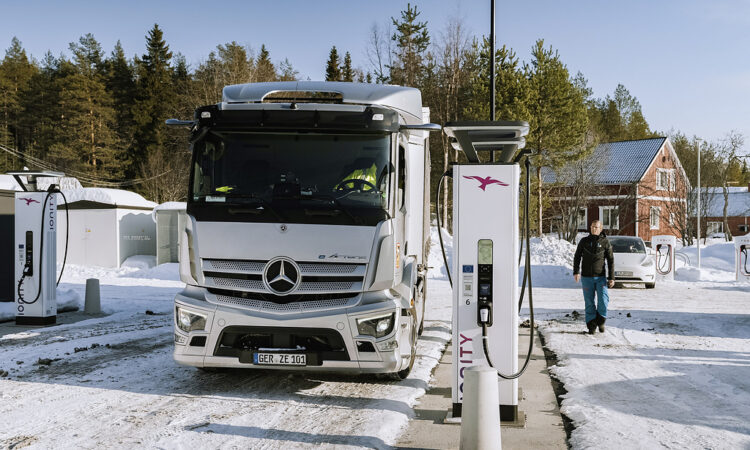- For maximum battery charging, we recommend preconditioning at the charging station.
- Additional battery drain due to low temperatures evens out with increasing mileage and operating heat after having driven off.
- Intelligent thermal and energy management ensures the correct temperature of the drivetrain and the driver’s cab even at low temperatures.
- The eActros can also perfectly handle snow-covered roadways without any issues.
Leinfelden-Echterdingen – Temperatures below zero and snow-covered or icy roads, less daylight and poor visibility: Winter always presents a special challenge for trucks and drivers. It goes without saying that battery-electric trucks, such as the eActros, must also be able to handle difficult weather conditions. After all, transport companies place the same requirements on them as on vehicles with diesel engines. Tests conducted by Mercedes-Benz Trucks in Rovaniemi, Finland at the beginning of 2023 once again showed that the eActros is fully operational even in very wintry conditions. But what really matters when it comes to handling the eActros in winter? The following questions and answers highlight some key aspects.
How do the batteries of the eActros react to low temperatures?
Regardless of which cell technology is installed: If the battery temperature drops due to the low outside temperature, the internal resistance of the battery increases. Power loss rises as a result, and slightly less energy content can be used. In order to reduce negative impacts on the range in cold ambient temperatures, you can use a selectable charging mode to precondition the battery at the charging station. The battery is heated, which reduces the internal resistance and enables maximum power consumption.
What exactly is the auxiliary climate control of the battery all about?
If the vehicle is parked in cold or warm ambient temperatures for a longer period of time and the battery reaches this temperature after many hours, the driver can set a departure time by which the battery is heated, cooled or brought to the optimum temperature.
What is the difference compared to normal battery conditioning?
During normal conditioning, the battery is automatically brought to the optimal operating window during operation. This occurs while driving or parking with the high-voltage on-board electrical system switched on. The high-voltage battery even remains at the ideal operating point within the framework of technical possibilities.
Down to what temperature below zero degrees Celsius can the batteries of the eActros still be charged?
At low temperatures, the heater switches on automatically during the charging process. The heating then warms the battery until current can flow again and the battery can be recharged. At temperatures below minus 19 degrees, the high-voltage battery system goes into self-protection mode in order to preserve the cell service life.
Up to which state of charge are eActros batteries charged in extremely low temperatures?
There is generally no lower limit. This is because the vehicle switches off in due time before a deep discharge. Irrespective of the temperature, the battery is always charged to 100 percent if the driver doesn’t set it otherwise.
Which factors can extend the charging time of the high-voltage battery?
For example, as a result of low or high battery temperatures. Charging times can also have a negative impact on the maximum available charging current of the charging station or the settings for the charging process in the onboard computer, e.g. with regard to the charging limit.
To which extent does the eActros’ range decrease in extremely cold temperatures?
It’s impossible to give a general answer, as many factors play a role here. If it’s very cold, it makes sense in any case to heat the cab and the battery. Please also note that the rolling resistance of the tires and the oncoming aerodynamic flow of cold air are higher at low temperatures. Cold drive bearings also have greater resistance, which also increases consumption. However, this additional consumption evens out with increasing mileage and operating heat after having driven off. Overall, in wintry conditions, consumption will be higher at the start and improve during operation throughout the day.
Does the eActros heat up faster or slower than a diesel-powered Actros?
Intelligent thermal and energy management of the eActros ensures that both the drivetrain and the driver’s cab are energy-efficiently pre-conditioned to the correct temperature, even at low temperatures. Thanks to its smaller, high performance heating circuit, the eActros heats the cab faster than a diesel-powered truck. However, since the energy for this is taken from the batteries installed in the vehicle, thus reducing the range, auxiliary climate control is once again recommended at the charging station. For the time after having driven off, it is also advisable to use only the panel heaters, such as seat heating or the windshield heater in order to save energy.
Does the eActros behave differently on the road in snow than a diesel-powered truck?
Extensive winter testing by Mercedes-Benz Trucks has shown that the eActros also proves its worth on snow covered roadways. Especially thanks to the lower center of gravity as a result of the positioning of the batteries, the eActros also has excellent traction in addition to its high vehicle dynamics. As with all Actros vehicles, the installed driver assistance and control systems can also contribute to safety. This also applies to MirrorCam, featuring compact cameras that are much less susceptible to dirt, for example from slush, than traditional main and wide-angle mirrors.
Can I put snow chains on the eActros?
Yes, there are no design-related restrictions in this respect.
Brummionline

